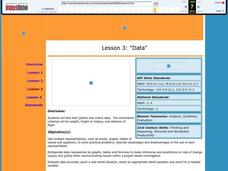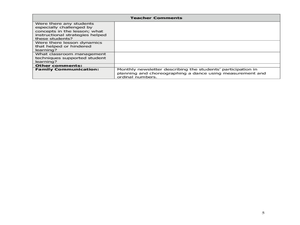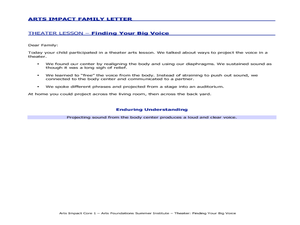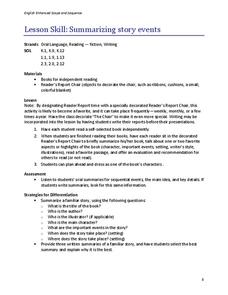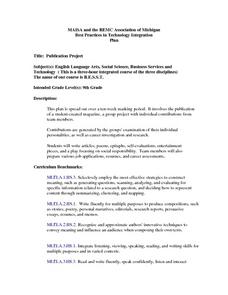Curated OER
"If you build it..."
Students utilize prior knowledge to erect and assemble a building from a drawing using spaghetti noodles and marshmallows. In this building lesson, students visualize a three dimensional structure from looking at a picture and converting...
Curated OER
Shake, Rattle, and Roll
Students make an earthquake simulator and test their structure to see if it lasts through the earthquake. In this earthquake lesson plan, students make a structure and test and record the results from an earthquake simulator made out of...
Curated OER
Data
Students collect data from an experiment they perform. In this data lesson, students use multiple representations to solve practical problems; describe advantages and disadvantages of the use of each representation. Then, they evaluate...
Curated OER
Patterns in Dance and Math
Students analyze how repeated body movements and shapes can represent and extend patterns. In this pattern analysis lesson, students discuss patterns in dance, math, and everyday living. Students demonstrate a dance using a sequence of...
Curated OER
Dance and Math
Second graders examine human body movements by measuring the choreography of a dance. In this physical education lesson, 2nd graders participate in a creative dance which is based on specific movements of each limb, which students...
Curated OER
Dancing Fast, Medium and Slow
Second graders practice dance using different speeds of music and types of movement. In this dance lesson, 2nd graders view a clip of tap dancing and analyze the speed of music in coordinating with the speed of dance movements. Students...
Curated OER
Finding Your Big Voice
Students use their diaphragm to create vocal vibrations, vocal sounds, and project sounds through an open space. For this sounds lesson plan, students learn how to use their voices to project through an auditorium.
Curated OER
Summarizing Story Events
Here is a way to build your pupils' public speaking abilities. The lesson describes a reader's report chair, which is used each week by a student who has just finished reading a book. The featured reader sits in the chair and talks about...
Curated OER
Summarizing Story Events
After reading a book on their own, pupils prepare an oral report on the book, and sit in the "Readers Report Chair" when giving the report to the class. They are taught to briefly summarize the book by talking about one of two favorite...
Curated OER
Using Part To Whole
Students engage in a math instructional activity that is concerned with developing problem solving skills. They emphasize the cognitive reasoning of seeing parts as pieces to a whole. Writing is integrated into a cross-curricular study...
Curated OER
Impact of Westward Expansion on Indigenous Populations
Students study the impact of westward expansion on Native American populations. They create a diorama of a Native American scene, write imaginary letters as a pioneer child reflecting on his/her experiences, and create story sticks that...
Curated OER
My State of the Union
Fourth graders, in groups, research states and using various print and nonprint reference materials. The groups make a presentation to inform the class about all the information from the state. This lesson plan provides imbedded support...
Curated OER
Staying Young with Vitamin E
Investigate how Vitamin E is used to prevent cell aging. Young scientists coat the surface of apples and bananas with oil, Vitamin E, and water. They place each in a petri dish and cover them to observe oxidation over time. They answer 8...
Curated OER
How Do I know That a Book Is Just Right for Me to Read?
Students choose a book for reading. In this language arts lesson, students take steps to evaluate a book for free reading. Students make a list of words found in the book that they are unfamiliar with.
Curated OER
Getting Caught In The Web
Sixth graders brainstorm the ways a person's actions can affect a community. As a class, one classmate is given a ball of yarn and pass it along to another student creating a web. Next, some classmates are asked to drop their part and...
Curated OER
ESL Grammar - Comma Splice
Learners fix comma splices. For this ESL lesson, students recognize comma splices and find ways to fix them. They complete a worksheet finding comma splices and correct sentences.
Curated OER
Gesture Drawing
Students investigate the use of proportion using gesture drawing as the subject matter. They create a painting using the elements of art and principles of design.
Curated OER
Monoprint
Students review Gerald Ferstman's work and discuss abstract art. They design and create monoprints on Mylar. They reflect on their work and write about the experience of creating the piece.
Curated OER
Publication Project
Ninth graders publish a magazine during a ten week marking period. They make individual contributions to the group project that is based on career choices. They write and publish articles, poems, entertainment pieces, and a play that...
Curated OER
Give a Hoot About Owls
Students research basic information about owls. They complete a class KWL chart, and conduct research on owls using the Internet and a variety of resource books. Next, they write an owl acrostic poem and a report using their research...
Curated OER
Candy Land
In this activity students pretend that they have been hired by a candy manufacturer to design a box for a new product they are beginning to market. The manufacturer has pre-determined the volume of the candy box. It is the students' job...
Curated OER
Dinosaurs---Read All About Them!
Students read all about dinosaurs. In this biology lesson plan, students examine how to use library research as integral part of scientific research.
Curated OER
Parallelism
Students use writing to show their understanding of parallel writing structures. For this ESL grammar lesson, students view PowerPoints, listen to short lectures and audio presentations. Students categorize phrases, write stories that...
Curated OER
Identifying and Describing Story Elements
First graders examine how to identify the different elements of a story and how they fit in a definite sequence. The use of comprehension skills is essential to retell the story as desired within the instructional activity.




